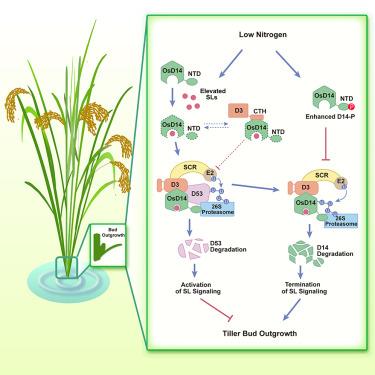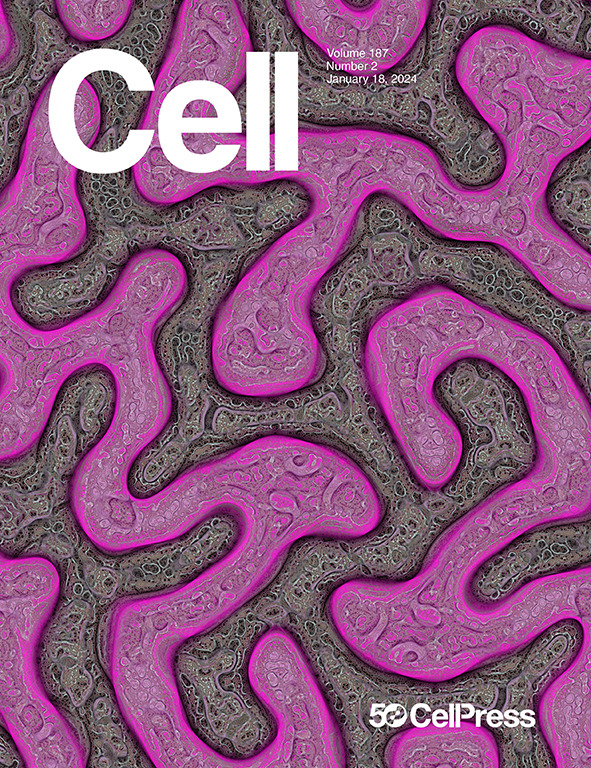水稻对绞股蓝内酯感知的调控机制
IF 45.5
1区 生物学
Q1 BIOCHEMISTRY & MOLECULAR BIOLOGY
引用次数: 0
摘要
硬脂内酯(SL)是植物发育和环境反应所必需的激素。SL的感知需要形成由SL受体DWARF14(D14)、F-盒蛋白D3和转录抑制因子D53组成的复合物,触发D53的泛素化和降解,从而激活信号转导。然而,SL 的感知机制及其对植物结构和环境响应的影响仍然是难以捉摸和有争议的。在这里,我们报告了 AtD14-D3-ASK1 复合物界面上的关键残基对于激活 SL 感知至关重要,发现过量表达 D3-CTH 基序会负向调节 SL 感知以增强分蘖,并揭示了磷酸化和 N 端紊乱(NTD)结构域在介导 D14 泛素化和降解中的重要性。重要的是,低氮会促进 D14 的磷酸化和稳定,从而抑制水稻分蘖。这些发现揭示了SL感知的激活、终止和调控的全景,而SL感知决定了植物在复杂环境中的可塑性。本文章由计算机程序翻译,如有差异,请以英文原文为准。

Regulatory mechanisms of strigolactone perception in rice
Strigolactones (SLs) are hormones essential for plant development and environmental responses. SL perception requires the formation of the complex composed of an SL receptor DWARF14 (D14), F-box protein D3, and transcriptional repressor D53, triggering ubiquitination and degradation of D53 to activate signal transduction. However, mechanisms of SL perception and their influence on plant architecture and environmental responses remain elusive and controversial. Here, we report that key residues at interfaces of the AtD14-D3-ASK1 complex are essential for the activation of SL perception, discover that overexpression of the D3-CTH motif negatively regulates SL perception to enhance tillering, and reveal the importance of phosphorylation and N-terminal disordered (NTD) domain in mediating ubiquitination and degradation of D14. Importantly, low nitrogen promotes phosphorylation and stabilization of D14 to repress rice tillering. These findings reveal a panorama of the activation, termination, and regulation of SL perception, which determines the plasticity of plant architecture in complex environments.
求助全文
通过发布文献求助,成功后即可免费获取论文全文。
去求助
来源期刊

Cell
生物-生化与分子生物学
CiteScore
110.00
自引率
0.80%
发文量
396
审稿时长
2 months
期刊介绍:
Cells is an international, peer-reviewed, open access journal that focuses on cell biology, molecular biology, and biophysics. It is affiliated with several societies, including the Spanish Society for Biochemistry and Molecular Biology (SEBBM), Nordic Autophagy Society (NAS), Spanish Society of Hematology and Hemotherapy (SEHH), and Society for Regenerative Medicine (Russian Federation) (RPO).
The journal publishes research findings of significant importance in various areas of experimental biology, such as cell biology, molecular biology, neuroscience, immunology, virology, microbiology, cancer, human genetics, systems biology, signaling, and disease mechanisms and therapeutics. The primary criterion for considering papers is whether the results contribute to significant conceptual advances or raise thought-provoking questions and hypotheses related to interesting and important biological inquiries.
In addition to primary research articles presented in four formats, Cells also features review and opinion articles in its "leading edge" section, discussing recent research advancements and topics of interest to its wide readership.
 求助内容:
求助内容: 应助结果提醒方式:
应助结果提醒方式:


